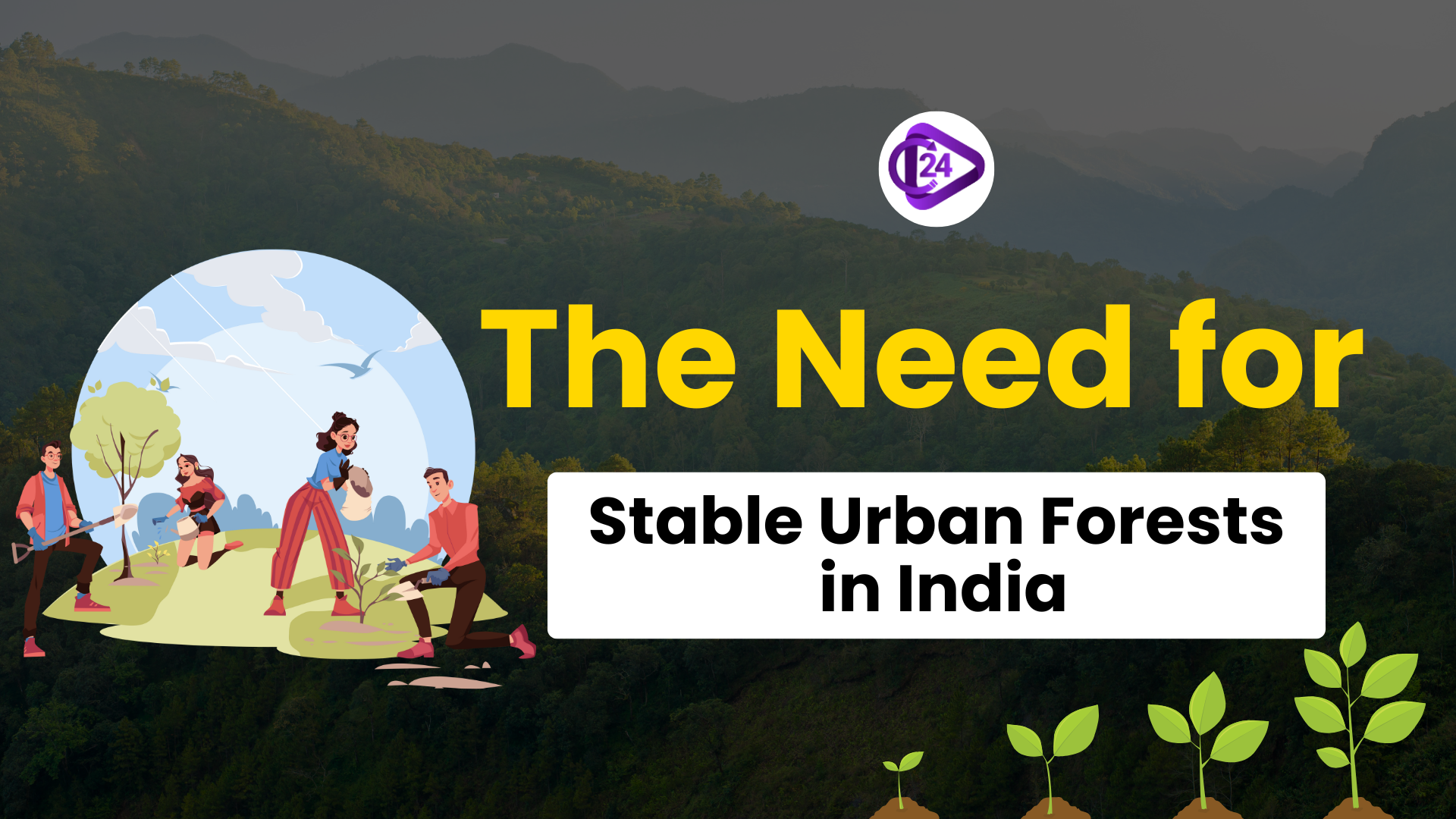
Due to fast urbanisation and careless development, urban forests which purify our air and bring greenery, are facing tremendous risks. What happened recently at Kancha Gachibowli in Hyderabad highlights how rapidly we should act to preserve such sites. It covers how urban forests play a role, when the law is involved, what policies exist to protect them and why public involvement matters.
What Makes Urban Forests Important?
The USDA found in a 2006 study that one hectare of forest can clean one ton of pollutants each year.
-
These urban forests in Hyderabad, Mumbai and Delhi support a variety of ecological, health and social purposes.
-
Climate Control: They keep towns from becoming hotter and reduce the negative effects of the urban heat island.
-
Trees reduce the amount of pollutants like PM 2.5 and PM 10 in city air which is good to know for places like Delhi and Chennai.
-
Forests can store carbon and control greenhouse gases.
-
They handle heavy stormwater so it doesn’t flood and so soil is preserved.
-
Endangered Species: Urban forests give these species a safe place to live.
-
Taking time in nature is good for your mind and social life, as it gives a break from busy city activities.
What are the concerns?
-
India’s cities are experiencing fast growth. While the economy develops, it can ignore the needs of the environment. For example:
-
About 100 acres of forest in Kancha Gachibowli were taken away for industrial use in Hyderabad.
-
Courts got involved after tree felling occurred in Bhopal and Allahabad.
-
The AQI in Delhi went up to 494 in 2024.
-
They indicate that urban planning is not sustainable and that urban ecosystems are poorly protected.
What roles does the court play?
Conservation of forests is regularly supported by the judiciary.
-
Godavarman Case (1996): Urban forest areas were brought into the definition of forests.
-
In 2015, the Delhi High Court prevented any harm to the Delhi Ridge forest.
-
In 2020, the Supreme Court stopped the process of tree cutting because of public protests.
-
Rajasthan HC (2024) acted by itself to defend the biodiversity of Baran.
What is Nagar Van Yojana?
-
The initiative was kicked off by the Ministry of Environment, Forest and Climate Change in 2020.
-
It intends to create 1,000 urban forests by the year 2027.
-
Tree cover has expanded by 1,445.81 sq. km, as the report from the Ministry of Environment, Forest and Climate Change in 2023 shows.
-
Such an approach fits India’s goals on climate and supports people in forest conservation.
Legal Provision Related to Forests
-
The Indian Forest Act, 1927
-
Gives forests three statuses: Reserved Forests, Protected Forests and Village Forests.
-
Gives the government authority to oversee forest use and name certain areas as forest land.
-
-
The Forest (Conservation) Act, 1980
-
Forest land can be used for purposes other than forests only with the government’s permission.
-
Strives to stop deforestation and ensure an unchanged balance in nature.
-
-
Wildlife (Protection) Act, 1972.
-
Protects the habitats of wildlife living in forest areas under law.
-
Forbids the killing and selling of threatened species.
-
-
Environment (Protection) Act, 1986
-
Helps the government act in protecting the environment and this includes forests.
-
The use of forest land is only permitted after assessment through an EIA framework.
-
-
The Scheduled Tribes and Other Traditional Forest Dwellers (Recognition of Forest Rights) Act, 2006, is known as the FRA.
-
Supports the rights that tribals and forest residents have to use the forest.
-
It gives local Gram Sabhas the power to deal with community forest resources.
-
Policy Related to Forest
-
National Forest Policy, 1988
-
Tries to maintain environmental stability, protect nature and involve all citizens.
-
Sets a goal of coverage of 33% of total land area by forest.
-
-
National Mission for Green India, 2014.
-
An element of the National Action Plan on Climate Change (NAPCC).
-
Tries to increase the number of trees and forests to support essential environmental process.
-
-
Nagar Van Yojana 2020
-
Works towards planting 1,000 urban forests in urban and nearby cities by 2027.
-
Enhances different kinds of living species, makes air cleaner and fosters interest from locals.
-
-
National Biodiversity Action Plan (NBAP)
-
Brings together forest conservation, the protection of biodiversity and sustainable use.
-
Constitutional Provisions related to forests
-
Under Article 21: Right to life.
-
The Supreme Court has decided that the right to a healthy environment includes forests.
-
-
Article 48A is a Directive Principle of State Policy.
-
Requires the State to preserve and improve the environment and guard forests and wildlife.
-
-
Article 51A(g) is entitled Fundamental Duties
-
Requires every citizen to help save and enhance forests, lakes and wildlife.
-
-
The 42nd Constitutional Amendment Act of 1976
-
7th Schedule of the Constitution, the Concurrent List includes what was formerly on the State List for shifted forests.
-
The Centre and the State can both make laws concerning forests.
-
Way Forward
-
Policy Guidance: Booming towns should incorporate green spaces into their infrastructure.
-
Urban residents should take part in caring for and overseeing nearby forests.
-
All States must legally notify and map every urban forest.
-
It is important to inform students, residents and developers.
-
Research shows that urban forests should be regularly looked after, preserved with data and planted with native species.
Conclusion
Going beyond looking pretty, urban forests actually help us live and feel sane in the midst of city life. Since India’s urban growth is rapid, saving these open greenlands is a requirement. Although judicial action is encouraging, real change needs citizens, policymakers and the courts to join forces. A healthy and aesthetically pleasing way of life for India needs to maintain our forests.



 Free Bus Schemes Help, But Rural India Pays More to Travel
Free Bus Schemes Help, But Rural India Pays More to Travel Keeladi Controversy-Conflict of Archaeology, Politics and Tamil Heritage
Keeladi Controversy-Conflict of Archaeology, Politics and Tamil Heritage Uttarakhand: A Persistent Hotspot for Helicopter Accidents
Uttarakhand: A Persistent Hotspot for Helicopter Accidents Empowering Women in Agriculture for Food Security
Empowering Women in Agriculture for Food Security Is India the World’s Fourth Largest Economy?
Is India the World’s Fourth Largest Economy? Rewriting the Script of Early Childhood Education: A Key to India’s Future Workforce
Rewriting the Script of Early Childhood Education: A Key to India’s Future Workforce Menstrual Hygiene Issues and Period Stigma: A Barrier to Girls’ Education in India
Menstrual Hygiene Issues and Period Stigma: A Barrier to Girls’ Education in India NEP 2020: Paving the Way for Practical, Pragmatic, and Innovative Education to Enhance Employability
NEP 2020: Paving the Way for Practical, Pragmatic, and Innovative Education to Enhance Employability Autism Care in India: A Call for Evidence-Based, Inclusive, and Early Intervention
Autism Care in India: A Call for Evidence-Based, Inclusive, and Early Intervention






